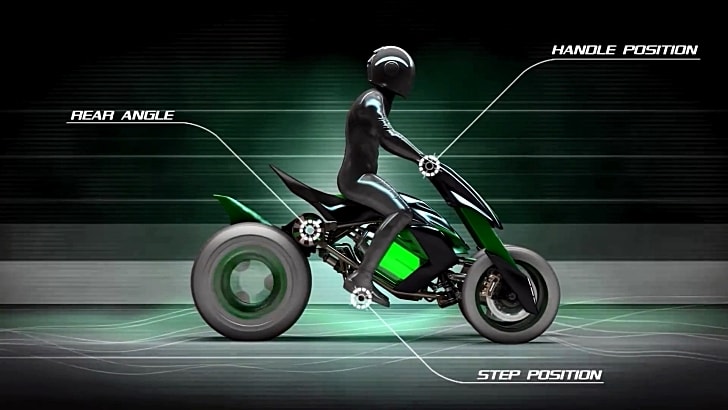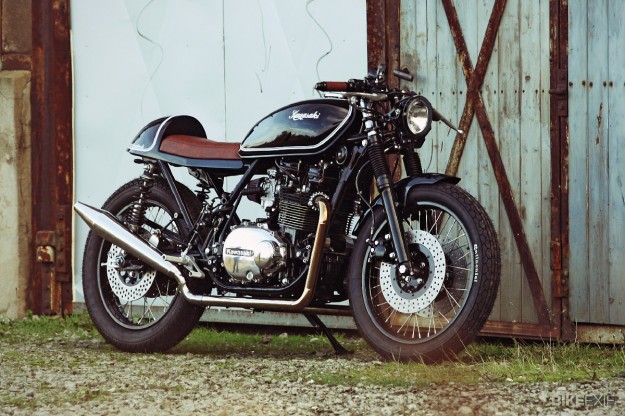 One of the things I love most about the new wave custom scene is the
healthy mix of professional and garage builders. While some use their
craft to put food on the table, others hold down day jobs—slogging away
at projects in their spare time.
Holger Breuer is one such builder. Since 2009, he’s been creating beautiful customs after-hours under the ‘HB Custom‘
moniker, while earning a living as an electrician in a dairy. This
1983-model Kawasaki Z 750 B is the eighth build to roll out of his
garage in Husum, Germany, and it exhibits a level of craftsmanship that
you’d expect from a full-time outfit.
One of the things I love most about the new wave custom scene is the
healthy mix of professional and garage builders. While some use their
craft to put food on the table, others hold down day jobs—slogging away
at projects in their spare time.
Holger Breuer is one such builder. Since 2009, he’s been creating beautiful customs after-hours under the ‘HB Custom‘
moniker, while earning a living as an electrician in a dairy. This
1983-model Kawasaki Z 750 B is the eighth build to roll out of his
garage in Husum, Germany, and it exhibits a level of craftsmanship that
you’d expect from a full-time outfit.

Holger was initially building bikes for himself and friends, but in 2012
a Z 750 that he customised won first place in a competition run by
Kawasaki Germany. The competition celebrated the 40th anniversary of the
Z-series and the bike was displayed at INTERMOT, thrusting Holger into
the spotlight. Since then he’s begun taking on commissioned work—such as
this ‘Z.’

It was sent to us by Fred Siemer, a motorcycle journalist who befriended
Holger while writing an article on him for the German magazine Motorrad Classic.
According to Fred, the Z 750 wasn’t very popular in Germany, making it
hard to find a good condition donor. This particular one hadn’t run in
ten years when Holger got his hands on it, so an engine overhaul was in
order, which included new clutch linings, pistons and an electronic
ignition.

Holger also installed Mikuni TM34 carbs, fabricated new exhaust headers
and fitted mufflers from Classicbike Raisch, which were originally
designed for Triumph’s modern twins. He then shortened the subframe to
house a hand-crafted alloy tail unit.
Suspension upgrades include Wilbers springs in the stock front forks
and Ikon shocks at the rear. The front brake is from a Kawasaki Z 650,
with a Honda CBR600RR master cylinder. Holger’s opted for a sporty
riding position—with Tarozzi rear sets and Tomaselli clip-ons.

Since Holger’s an experienced electrician, the wiring has been neatened
up significantly and a new Lithium-ion battery hidden inside the tail.
The cockpit has also been cleaned up, with Motogadget‘s
Motorscope Tiny speedo and m-Switch controls replacing the clunky stock
units. The final finish is classic and elegant—gloss black with white
striping and brown accents.
“In the beginning, Holger said he was influenced by Wrenchmonkees,”
says Fred. “In my opinion, you can still see it a little—but with this
noble and even cool bike and its high end finish, he’s defined his very
own style.”
Visit Holger’s website at www.hb-custom.de to see more of his work. Photos by Timo Meinking.
First appeared in www.bikeexif.com

Shannon Snow manages the engine department of a small race car
manufacturer in Denver, Colorado, so it’s fair to say he should have the
skills to put together any kind of machine he wants, so it’s great to
see that he stretched himself into creating something very different
from the usual run-of-the-mill custom. The bike was put together for
Deus ex Machina Build-off last year in Venice Beach, so Shannon knew he
was going to have to build something that would really stand out, and he
didn’t let himself down..

The donor started out as an 80′s dirtbike monoshock frame, sourced
for free from Craiglist, which came with an unknown model Bultaco gas
tank. The search began for a motor and a $300 XT200 soon turned up,
which Shannon started-up and test rode by running it up the street and
back again, before pulling the motor out for his project build, …but it
wasn’t a straight fit. “I had to hack, weld and shoehorn the XT
motor into the 2 stroke frame. I modified the rear swing arm and frame
to accept an R6 shock that I paid $20 for years ago. I cut about a foot
off the front forks and springs. Not having a lathe to re thread the
tube, I drilled and tapped the caps for pipe plugs and then welded the
caps to the fork tubes.”

“I
added mountain bike shocks as helper springs to stiffen the front end,
which gave my bike its iconic face. The light is a PIAA fog light that
came off a previous bike I had owned. The handle bars are mini apes I
had stripped from a project CB550, and then flipped them”. As well
as mixing and matching parts from outside the usual motorcycle parts
catalog, Shannon also used whatever he could find, and when it came to
labour he even got his family involved. “The seat foam came from a
Kawasaki 440Ltd that I had in high school. My mother in law did the
upholstery. I made the tail from a stainless steel bowl from Walmart.
The ignition module and regulator are housed inside. I did it all in my garage for under $600.”

The colour scheme happened by accident. “The paint is spray
paint, not quite as nice as I would have liked but just ran out if time!
I planned on a gunmetal base coat, but the stripes were originally
going to be a metallic bronze, but when I put painter’s tape on to mock
up the stripe widths, I liked the color of the green & blue tapes so
I went with it…”
So, how do we describe this machine? The front end has a vintage
board-tracker vibe, while the mono-shock and knobbly tyres suggest an
80′s street tracker, but the seat is pure cafe racer… Maybe we’d better
ask Shannon? “I would describe the bike as a brat-tracker-café
racer, it’s fun to ride, even though the ergonomics are a bit extreme,
definitely not a long haul cruiser but fun to buzz around on. I’m happy
with how it turned out with the time and budget afforded the project. ”
And how did it go down in the Deus ex Machina build-off? The bike was
placed 2nd at the event, and 8th in the world. Not bad for a project
that Shannon doesn’t even consider to be properly finished yet, as he’s
already planning a re-spray with proper automotive paint.
Ok Shannon, what next? “My next project is a GL1100,
streetfighter/café racer, I have a pile of parts and am working on the
drawings. The plan is to graft a late model single sided swingarm and a
custom front suspension and fuel inject it.” We look forward to seeing it on The Bike Shed. Thanks for sharing, and best of luck.
First appeared in Thebikeshed
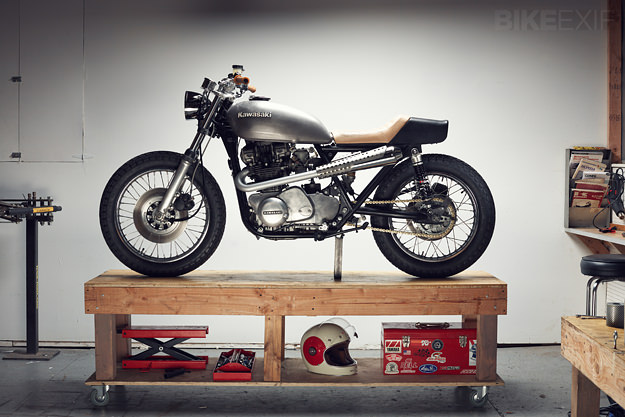 The name Chad Hodge
should sound familiar. He designed the sensational Bullitt helmet
concept a few years ago—a retro, full-face design that’s since been
picked up by Bell and is about to go on sale.
Originally from Louisville, Chad works as industrial designer out of
his shop in Brooklyn. This 1978-model Kawasaki KZ750B is his first
custom build and, coincidentally, the first motorcycle he ever owned.
“I got it 10 years ago when I was 18 but never got it running right”,
says Chad. “The starter clutch was toast and the kickshaft bent, so I
abandoned it for other bikes. I ended up selling it to a friend who also
let it sit around, only to buy it back last year to give it a new
life.”
The name Chad Hodge
should sound familiar. He designed the sensational Bullitt helmet
concept a few years ago—a retro, full-face design that’s since been
picked up by Bell and is about to go on sale.
Originally from Louisville, Chad works as industrial designer out of
his shop in Brooklyn. This 1978-model Kawasaki KZ750B is his first
custom build and, coincidentally, the first motorcycle he ever owned.
“I got it 10 years ago when I was 18 but never got it running right”,
says Chad. “The starter clutch was toast and the kickshaft bent, so I
abandoned it for other bikes. I ended up selling it to a friend who also
let it sit around, only to buy it back last year to give it a new
life.”
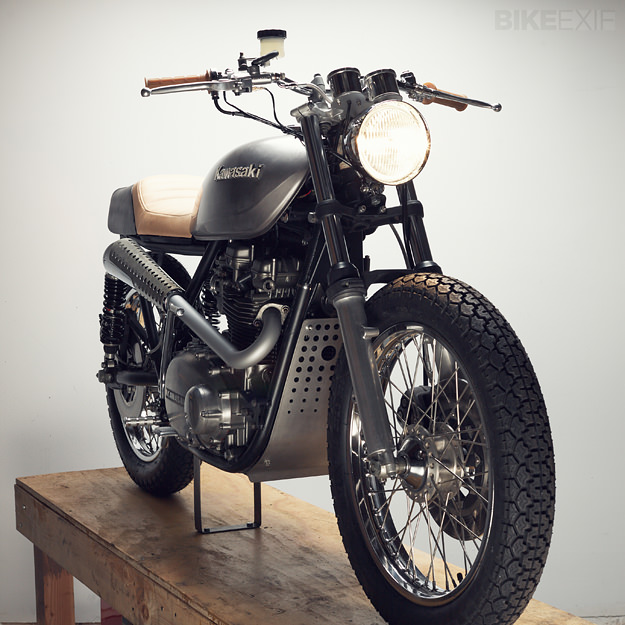
First on Chad’s list was a complete engine rebuild, including a new
kickshaft. He cleaned up the frame, replaced all the bearings and made a
new, streamlined wiring harness. Chad also installed an electronic
ignition and rebuilt the wheels—wrapping them in Dunlop K70s. He
upgraded the front forks with progressive springs and a fork brace, and
fitted new YSS shocks at the rear.
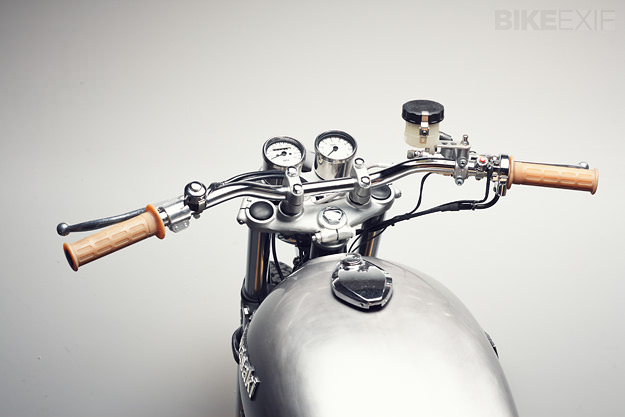
Once the bike was running as it should, he turned his attention to
cosmetics. “I wanted the bike to kind of look like an old race bike with
a tracker stance. I love F1 race cars from the 1960s and the
functional, precise but also handmade look that the different components
had.”
Chad shortened the KZ750′s stock tail unit before sending it to New Church Moto
in Portland for fresh upholstery. It now houses the battery and
taillights—discreetly tucked away behind a bespoke mesh cover and only
visible when lit. “I had to build custom light housings and cones to
make the whole light assembly,” he explains. “I think that turned out to
be my favorite part of the bike.”
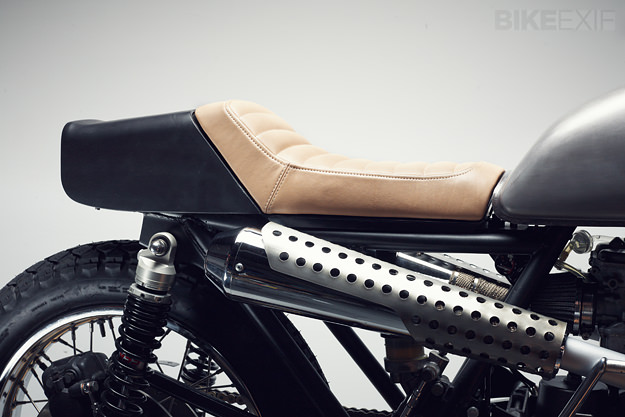
The exhaust headers were re-routed at a sharp angle for a more
aggressive look. They terminate in reverse cone mufflers wrapped in
tailor-made heat shields that, according to Chad, work rather
effectively.
He decided on a bare-metal-and-black color scheme while prepping the
bike for paint. “Originally I had a different color in mind for the tank
and tail, but once I stripped the tank and saw the metal I was hooked.”
Gum grips were added to match the seat, and the handlebar controls were
swapped out for cleaner-looking items.
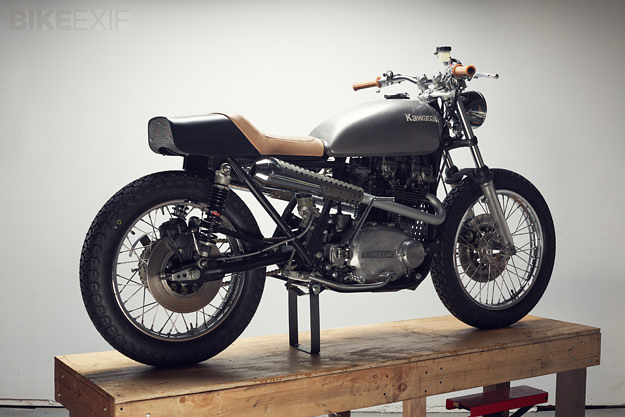
Chad’s pretty happy with how the KZ750 turned out: “It was a really fun
bike to work on, and it’s even more fun to ride. It’s light and quick.”
The good news is that he’s hoping to take on more builds in the
future. I’d say that’s something to look forward to, wouldn’t you?
To explore the bike in more detail, head over to the high-resolution gallery on our Google+ page. Images by Blaine Davis. To get in touch with Chad, see his work or commission a project, visit his site at chadhodgedesign.com.
first appeared in www.bikeexif.com by Wesley Reyneke | Rather Be Riding
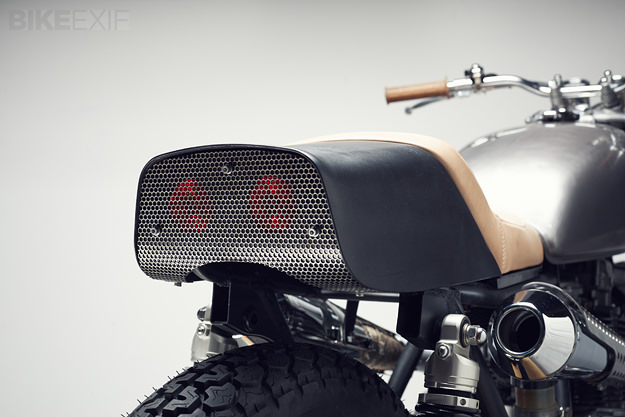
 Z750 Twins just make the perfect donor for a scrambler or brat style
custom build. It’s all there – the tapered tank, the picture-perfect
twin-cylinder engine with one pipe aside and a nice simple set of tubes
making up a chassis just begging to be stripped and simplified. This
beauty belongs to Johan from Sweden – clearly a man of good taste, who,
apart from building this lovely 750 owns a clothing store, espresso bar
and surfshop (surfing, in Sweden?)… The shop is named “6/5/4″ after the
type of wetsuit required to surf the cold Swedish waters. We assume it’s
about an inch thick.
Z750 Twins just make the perfect donor for a scrambler or brat style
custom build. It’s all there – the tapered tank, the picture-perfect
twin-cylinder engine with one pipe aside and a nice simple set of tubes
making up a chassis just begging to be stripped and simplified. This
beauty belongs to Johan from Sweden – clearly a man of good taste, who,
apart from building this lovely 750 owns a clothing store, espresso bar
and surfshop (surfing, in Sweden?)… The shop is named “6/5/4″ after the
type of wetsuit required to surf the cold Swedish waters. We assume it’s
about an inch thick.
 “I got hold of a garage in the same building we use for storage
for 6/5/4. There was some room left over and I found this really cool
Royal Enfield from ’72. I bought it, and I also bought a toolbox, and
that was when it all started…” Johan then found himself on Google,
looking at inspiration for builds, which is when he discovered Deus,
Iron & Resin, The Wrenchmonkees (and of course The Bike Shed?) and
within a few months 6/5/4′s storage facility had been morphed into a
full-blown garage.
“I got hold of a garage in the same building we use for storage
for 6/5/4. There was some room left over and I found this really cool
Royal Enfield from ’72. I bought it, and I also bought a toolbox, and
that was when it all started…” Johan then found himself on Google,
looking at inspiration for builds, which is when he discovered Deus,
Iron & Resin, The Wrenchmonkees (and of course The Bike Shed?) and
within a few months 6/5/4′s storage facility had been morphed into a
full-blown garage.
 Johan, also known as Jovve, decided to call on his friends and see if
they wanted to join him in his new venture. Five of them rolled up
their sleeves to pitch in to the 6/5/4 Motors project including Daniel
“Yakko” who had his Yamaha xs750
featured on The Bike Shed a few months ago. Jovve’s team is now nine,
and they’ve had to move into a bigger garage with over 100 square metres
to work in.
Johan, also known as Jovve, decided to call on his friends and see if
they wanted to join him in his new venture. Five of them rolled up
their sleeves to pitch in to the 6/5/4 Motors project including Daniel
“Yakko” who had his Yamaha xs750
featured on The Bike Shed a few months ago. Jovve’s team is now nine,
and they’ve had to move into a bigger garage with over 100 square metres
to work in.
 This bike is a 1979 Kawasaki z750 twin and was sourced online in
Sweden. Jovve wanted to build her into a scrambler with wire-spoke
wheels, and it’s no surprise that he cites the Wrench Monkees as
inspiration for the overall build style. They have excelled in turning
Z750s into some of the most desirable customs out there, and have
inspired more than a few similar builds in recent years.
This bike is a 1979 Kawasaki z750 twin and was sourced online in
Sweden. Jovve wanted to build her into a scrambler with wire-spoke
wheels, and it’s no surprise that he cites the Wrench Monkees as
inspiration for the overall build style. They have excelled in turning
Z750s into some of the most desirable customs out there, and have
inspired more than a few similar builds in recent years.
 The subframe has been shortened and looped to fit the aluminium seat
pan, upholstered in vintage cognac brown leather which came from one of
Jovve’s leather goods suppliers. The engine was polished and the tank
taken back to the raw metal before being given a coat of clear matte
lacquer. In contrast the frame has been painted gloss brown, adding a
little warmth to the overall colours but still keeping it cool and
muted. A 6/5/4 logo on the flanks on the tank provides the makers
marque.
The subframe has been shortened and looped to fit the aluminium seat
pan, upholstered in vintage cognac brown leather which came from one of
Jovve’s leather goods suppliers. The engine was polished and the tank
taken back to the raw metal before being given a coat of clear matte
lacquer. In contrast the frame has been painted gloss brown, adding a
little warmth to the overall colours but still keeping it cool and
muted. A 6/5/4 logo on the flanks on the tank provides the makers
marque.
 The new motocross handlers boast a Nissin master cylinder and black
Beston grips. The front and rear lights are of course Bates style, with a
five and three quarter inch unit at the front. There’s a high
performance battery tucked under the seat in a black box and the wiring
is all new.
The new motocross handlers boast a Nissin master cylinder and black
Beston grips. The front and rear lights are of course Bates style, with a
five and three quarter inch unit at the front. There’s a high
performance battery tucked under the seat in a black box and the wiring
is all new.
 The air box was ditched with the carbs running open filters and the
wrapped exhaust is tipped with mini zoom end cans. The tyres are big fat
military Firestones, running 4.5 inches at the back and 4 inches at the
front.
The air box was ditched with the carbs running open filters and the
wrapped exhaust is tipped with mini zoom end cans. The tyres are big fat
military Firestones, running 4.5 inches at the back and 4 inches at the
front.
 It’s a great looking bike and one we’d love to have in The Bike Shed
garage, and a great build for a fledgling new business. Next up from
6/5/4 Motors will be a 1976 Ducati 860GTS which is set to be a cafe
racer.That should prove to be an interesting challenge, and we look
forward to sharing it with you all on The Bike Shed. See more from Jovve
and 6/5/4 on their Website.
First appeared in thebikeshed.cc
It’s a great looking bike and one we’d love to have in The Bike Shed
garage, and a great build for a fledgling new business. Next up from
6/5/4 Motors will be a 1976 Ducati 860GTS which is set to be a cafe
racer.That should prove to be an interesting challenge, and we look
forward to sharing it with you all on The Bike Shed. See more from Jovve
and 6/5/4 on their Website.
First appeared in thebikeshed.cc
The flash of green and bare alloy emerges from a London side street.
The rider, black visor down, looks both ways, and accelerates into a gap
in front of a red bus.
The bike is obscured by traffic. There is only the bus’s burp of
diesel smoke and a question left to consider: Was that really a Kawasaki
KR750?
It had the bubble screen, the Gary Nixon/Erv Kanemoto paint and
distinctive up-turned tailpiece. But something wasn’t quite right. It
didn’t sound like a schizophrenic big-bore, two-stroke triple. Nope,
definitely not.
The truth is Aaron Perrott’s tribute to the famous two-stroke raced
at the TT by Mick Grant, and in the Formula 750 Championship by Gary
Nixon, is also a product of Kawasaki Heavy Industries, but a relatively
humble ER-6f.
After seeing a Kawasaki W800 customised by UK custom company Spirit
of the Seventies, Aaron entrusted his daily-ride 650cc twin to the
Kent-based customisers.
It was Spirit’s Tim Rogers and Kev Taggart who suggested it should be
converted in a KR750 style, but the bike’s owner laid down some very
specific guidelines.
“I didn’t want to change the chassis at all,” Aaron explains.
That meant Spirit couldn’t remove a single bracket from the frame,
normally one of the first jobs of any build. With that water-tight
brief, the transformation they’ve made is even more astonishing.
The ER-6 first won fans for being a no-nonsense commuter with style
and enough buzz to raise it above the opposition. It then gained extra
credibility when Irish real road racing legend Ryan Farquhar proved the
middleweight Kawasaki made a blistering North West 200 and TT bike in
Supertwin trim.
Tuners in the UK and USA regularly praise the 650’s very modern head
and combustion chamber design and the cassette-style gearbox.
So, while it’s not exactly a sheep in wolf’s clothing, it was still a
big ask to make a 2008 four-stroke twin road bike look like a 1975
two-stroke racer.
pirit used their connections to find a suitable fairing without
having to invest in having a replica KR750 bodykit made from scratch.
They found a mould of an old Bimota race fairing. They are tight-lipped
about the exact model (a 1981 KB2?). The fairing was cut to allow the
radiator and exhaust headers to clear the fibreglass. The bubble screen
was made as a one-off by UK specialists Skidmarx.
The seat, that I would have bet my house on being a KR750 pattern
part, is actually a modified Suzuki TR750, another monster two-stroke
factory racer from the mid-1970s. The fibreglass seat has been widened
and cut about, because, again, Aaron didn’t want the subframe modifying
in any way.
“I watched the project progress but it was difficult to see how it
would all come together,” admits the owner. “We went back and forth on
the tank. I wasn’t sure if I wanted to go down the custom-made tank
route.”
Spirit’s design whizz Kev knew it needed a new tank to be a really
successful project and pushed Aaron to go the extra mile. In the end the
owner, a 37-year-old IT expert, agreed and now admits it’s the making
of the project, though it took a lot of financial commitment. “Think of a
number and double it,” Kev says when I ask him how much it cost.
People who can, and are willing to, make this quality of tank are few
and far between in modern Britain. Spirit ended up contacting a vintage
car bodywork specialist, the details of whom they’re keeping under
their hats.
This is his first ever motorcycle tank and it’s a lovely job. It even
has the quick-filler blanking plate in the side featured on some 1970s
Daytona 200 bikes – like Nixon’s KR750.
But where the 1970s race bike had a painted tank, it seemed sacrilege
to cover the workmanship, so the hand-beaten alloy was left bare. This
is, after all, an homage to the racer, not a replica.
One element that Aaron thought was a dead giveaway that his street
racer was once a common-or-garden ER-6 was the distinctive side-mount
monoshock unit, so he and Spirit came up with the idea of disguising it
with an R&G Shocktube.
Spirit don’t rely on any particular company when it comes to bolt-on
parts, instead choosing what is appropriate for each bike. For this
Kawasaki the list includes Italian ValterMoto rearsets and LSL clip-ons
with Oberon bar-end indicators. The only engine mod is the Arrow exhaust
system.
The paint is something completely new to me: a matt, almost
rubberised finish laid on by D-Luck of Brighton. Apparently, the finish
is attained by spraying at low pressures. It’s also tricky to keep
clean, reckons Aaron, the matt finish acting like a magnet for greasy
fingerprints.
It does look gorgeous up close. The Spirit of the Seventies logo on
the tailpiece is a clever take on the old Heuer timing systems logo,
while the number 8 on the side is Aaron’s old race number from when he
used to compete in enduros.
Aaron spent over £10,000 on the transformation, but the bike retains
completely standard cycle parts. The wheels, brakes and suspension are
just the same as the bike left the factory with.
You could look at that two ways: Kawasaki know what they’re doing, so
if this is a daily or regular rider then stick to that and you can’t go
wrong; on the other hand you could say the donor bike was conceived as a
budget bike and the suspension was the weak point of the package from
day one.
Aaron’s happy enough with it, and was determined that the whole
make-over would be reversible, so the Kawasaki could be returned to
standard in a day, without welding. We’re astonished how radical the
bike looks considering those constraints.
Aaron competed on the bike before Spirit got hold of it. “I raced the
standard bike at a couple of hillclimbs, Prescott and Shelsey Walsh. I
did some track days, too, and I’m going to ride it on track now it’s
customised.”
Everything works perfectly. Spirit’s conversions aren’t cheap, but
they’re done right. “The attention to detail is impressive,” says Aaron.
“They even measured my inside leg to make sure they didn’t make the
seat too tall.”
On my short road test, it was pure feelgood. The performance is
identical to standard with an exhaust that has more bark than standard,
but still isn’t antisocial. If you’re coming from a Ninja 250 the bike
is a beast, if you’ve just climbed off a ZX-10R – it’s limp.
“I’m commuting on it at the moment,” Aaron reminds me. “When the
streetlights are reflecting off the bubble I feel like I’m at Le Mans.
The riding position and the exhaust note make me want to ride faster.
And it’s got a fantastic silhouette. I love it when I see my reflection
in a shop window. I’m happy with everything about it.”
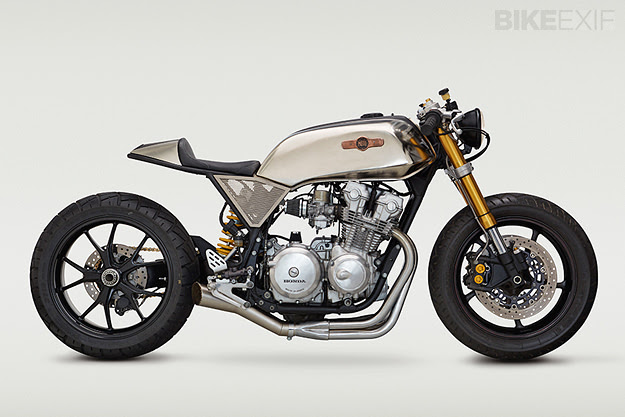
It’s been a huge year for custom motorcycles. They’re back with a bang,
and the mainstream media has noticed. Even the Financial Times has
picked up on the resurgence, reporting on The Comeback of the Cafe Racer. And most of the biggest-selling motorcycle magazines have added ‘new wave’ customs into the monthly editorial mix.
Manufacturers are getting in on the game too. Yamaha Europe is
working closely with builders such as Deus, the Wrenchmonkees and Kedo.
And BMW has enlisted the services of Roland Sands, El Solitario, Blitz
and Urban Motor.
It’s great news for motorcycling in general, and not just the custom
scene: Bikes that are simple and fun and easy to personalize are making
their way into the showrooms, such as Moto Guzzi’s extended V7 range and
now Yamaha’s reborn SR400.
So let’s take a look back at 2013, and pick out the motorcycles that
were the biggest hits on Bike EXIF. As always, we look at traffic
figures, social media shares, comments and the number of incoming links.
We balance this with the age of the post, so that more recent machines
are not disadvantaged.
1. Honda CB cafe racer by Classified Moto
[top]. For the second time in a row, a Classified Moto bike has taken
the top spot. It seems like John Ryland can do no wrong, with a
distinctive aesthetic all of his own and a burgeoning order book.
‘Superstrada’ is a heavily customized 1980 Honda CB750F Super Sport,
with a Yamaha YZF-R6 front end, Classified Moto’s signature triple tree
conversion, and a single-sided Ducati swingarm.
 2. Ducati Monster 1100 by JvB-Moto
[above]. Ten years ago, Jens vom Brauck won Ducati’s International
Design Contest with a retro-futuristic concept called ‘Flat Red.’ He’s
now an established builder with a string of stark, brutal-looking
machines to his name. At the Glemseck 101 festival in Germany, Jens
revealed Flat Red II—and set the interwebs alight.
2. Ducati Monster 1100 by JvB-Moto
[above]. Ten years ago, Jens vom Brauck won Ducati’s International
Design Contest with a retro-futuristic concept called ‘Flat Red.’ He’s
now an established builder with a string of stark, brutal-looking
machines to his name. At the Glemseck 101 festival in Germany, Jens
revealed Flat Red II—and set the interwebs alight.
 3. Ducati 900 by Walt Siegl
[above]. To move beyond bolt-on parts takes hours of craftsmanship, and
true artisans don’t come cheap. Walt Siegl has taken a big step to
correct the imbalance with his new Leggero Series, a limited run of
production machines based on two-valve Ducati 900cc engines. This is the
prototype: you can now order one for yourself.
3. Ducati 900 by Walt Siegl
[above]. To move beyond bolt-on parts takes hours of craftsmanship, and
true artisans don’t come cheap. Walt Siegl has taken a big step to
correct the imbalance with his new Leggero Series, a limited run of
production machines based on two-valve Ducati 900cc engines. This is the
prototype: you can now order one for yourself.
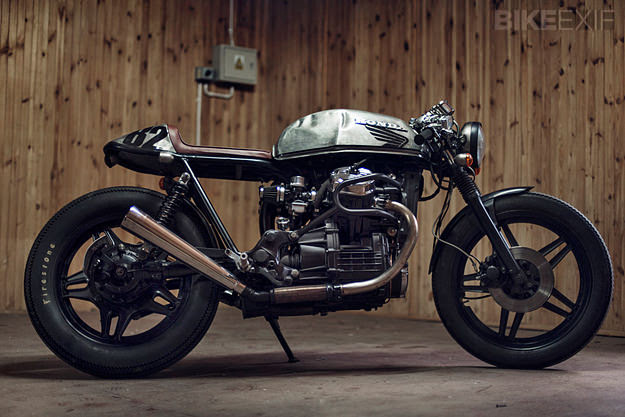 4. Honda CX500 by Mateusz Stankiewicz
[above]. The CX500 is a tough and reliable bike, and still cheap on the
secondhand market. This 1982-model custom, built by a Warsaw
photographer and the garage Eastern Spirit, was the surprise hit of the
year—and made it onto the cover of the 2014 Bike EXIF wall calendar.
4. Honda CX500 by Mateusz Stankiewicz
[above]. The CX500 is a tough and reliable bike, and still cheap on the
secondhand market. This 1982-model custom, built by a Warsaw
photographer and the garage Eastern Spirit, was the surprise hit of the
year—and made it onto the cover of the 2014 Bike EXIF wall calendar.
 5. Yamaha SR500 by Analog Motorcycles
[above]. Tony Prust builds elegant, mid-capacity customs: the perfect
bikes for barhopping and cruising around town. This 1979 Yamaha SR500
has more of a raw edge though, and a name to match—‘Bruto.’ It’s a
machine for evening and weekend rides, with a seat big enough for two.
5. Yamaha SR500 by Analog Motorcycles
[above]. Tony Prust builds elegant, mid-capacity customs: the perfect
bikes for barhopping and cruising around town. This 1979 Yamaha SR500
has more of a raw edge though, and a name to match—‘Bruto.’ It’s a
machine for evening and weekend rides, with a seat big enough for two.
 6. Kawasaki W650 by Skuddesign
[above]. Nicolas Barthelemy got the blend of drop-dead gorgeous looks
and practicality just right for this Kawasaki. “I wanted to mix
aesthetic codes—bobber, brat style and street tracker—to create a
motorcycle that corresponds to my world,” he says. The bike is now one
of the stars of our best-selling book, The Ride: New Custom Motorcycles and Their Builders.
6. Kawasaki W650 by Skuddesign
[above]. Nicolas Barthelemy got the blend of drop-dead gorgeous looks
and practicality just right for this Kawasaki. “I wanted to mix
aesthetic codes—bobber, brat style and street tracker—to create a
motorcycle that corresponds to my world,” he says. The bike is now one
of the stars of our best-selling book, The Ride: New Custom Motorcycles and Their Builders.
 7. Moto Guzzi V50 by Rno Cycles
[above]. Think of a custom Moto Guzzi, and it’s invariably built in the
‘classic’ style: Timeless café racer lines, muted colors and bare
metal. So it’s refreshing to see someone take a completely different
approach—and pull it off spectacularly. This rapier-sharp V50 is called
‘Opal’ and comes from Arno Overweel of The Netherlands.
7. Moto Guzzi V50 by Rno Cycles
[above]. Think of a custom Moto Guzzi, and it’s invariably built in the
‘classic’ style: Timeless café racer lines, muted colors and bare
metal. So it’s refreshing to see someone take a completely different
approach—and pull it off spectacularly. This rapier-sharp V50 is called
‘Opal’ and comes from Arno Overweel of The Netherlands.
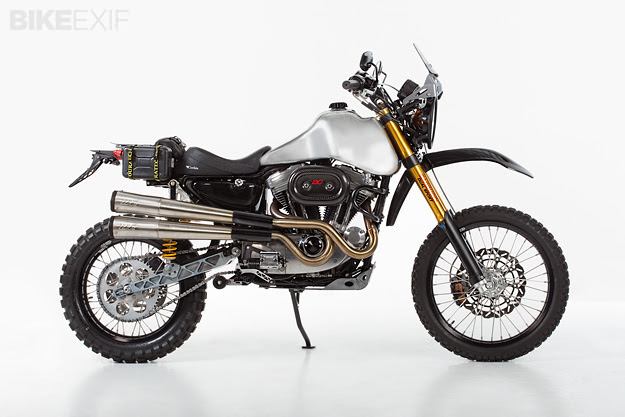 8. Harley dual sport by Carducci
[above]. A Harley Sportster-based dual sport bike? It might sound
improbable, but engineer Jim Carducci has built just such a beast. And
with a torquey, reliable motor plus 8+ inches of rear wheel travel and
10+ inches of front wheel travel, it actually works.
8. Harley dual sport by Carducci
[above]. A Harley Sportster-based dual sport bike? It might sound
improbable, but engineer Jim Carducci has built just such a beast. And
with a torquey, reliable motor plus 8+ inches of rear wheel travel and
10+ inches of front wheel travel, it actually works.
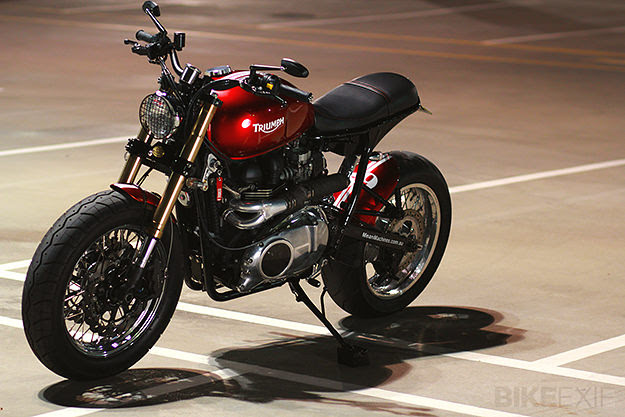 9. Triumph Bonneville by MeanMachines
[above]. This Triumph Bonneville looks like it’s poised to shred
rubber, even when it’s standing still. It’s the work of MeanMachines, an
Australian shop very familiar to local owners of Bonnevilles and
Thruxtons. Builder Wenley Ng has been modifying Triumph ‘modern
classics’ for many years now, but fitting that 200-section rear tire was
still a challenge.
9. Triumph Bonneville by MeanMachines
[above]. This Triumph Bonneville looks like it’s poised to shred
rubber, even when it’s standing still. It’s the work of MeanMachines, an
Australian shop very familiar to local owners of Bonnevilles and
Thruxtons. Builder Wenley Ng has been modifying Triumph ‘modern
classics’ for many years now, but fitting that 200-section rear tire was
still a challenge.
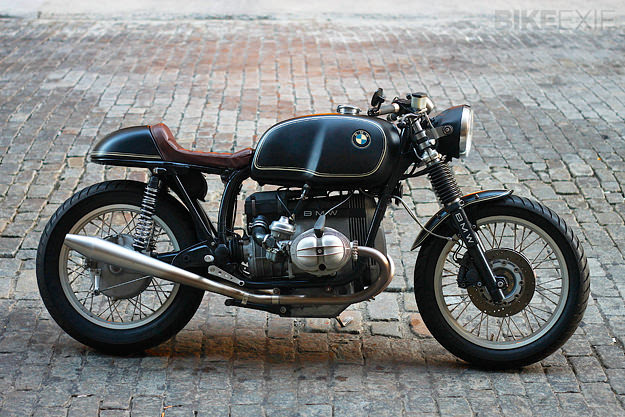 10. BMW R100RT by Bill Costello [above]. There were cries of outrage when Bill’s R100RT was omitted from our recent Top 5 BMW R-series
piece. Bill made his name with an R50 custom that caught the attention
of BMW’s top brass in Germany, but this time he wanted a reliable daily
rider. He’s also put the bike on a diet, dropping the wet weight from
around 525 lbs to 430.
A handful of machines narrowly missed the cut, including the
Sprintbeemer, Valen Zhou’s remarkable Honda CB125 and Café Racer Dreams’
NX650. Indeed, if you aggregate all of CRD’s builds, the Spanish
company would join Classified Moto, Deus and Rough Crafts as the biggest
traffic sources for Bike EXIF.
So that’s our round-up for 2013. With almost 25 million pageviews,
270,000 Facebook fans and over two million followers on Pinterest, we’ve
had a good year.
We hope yours has been good too. Thank you for joining us, and here’s to a 2014 filled with many more exciting bikes.
The post Top 10 custom motorcycles of 2013 appeared first on Bike EXIF. If you like Bike EXIF, you'll love our book on custom motorcycles and their builders, "The Ride." Get your copy here.
10. BMW R100RT by Bill Costello [above]. There were cries of outrage when Bill’s R100RT was omitted from our recent Top 5 BMW R-series
piece. Bill made his name with an R50 custom that caught the attention
of BMW’s top brass in Germany, but this time he wanted a reliable daily
rider. He’s also put the bike on a diet, dropping the wet weight from
around 525 lbs to 430.
A handful of machines narrowly missed the cut, including the
Sprintbeemer, Valen Zhou’s remarkable Honda CB125 and Café Racer Dreams’
NX650. Indeed, if you aggregate all of CRD’s builds, the Spanish
company would join Classified Moto, Deus and Rough Crafts as the biggest
traffic sources for Bike EXIF.
So that’s our round-up for 2013. With almost 25 million pageviews,
270,000 Facebook fans and over two million followers on Pinterest, we’ve
had a good year.
We hope yours has been good too. Thank you for joining us, and here’s to a 2014 filled with many more exciting bikes.
The post Top 10 custom motorcycles of 2013 appeared first on Bike EXIF. If you like Bike EXIF, you'll love our book on custom motorcycles and their builders, "The Ride." Get your copy here.
We reported earlier about Kawasaki's all-new J Concept
vehicle which was recently shown at the Tokyo Motor Show in Japan, and
now we're bringing you some more J-action in the form of a video
rendering of how this intriguing machine changes shape.
Now, ticking the appropriate box for the Kawasaki J is a really hard
task: this concept is not a motorcycle or a trike, and neither is it a
scooter or quad. I'd say this build simply introduces a class of its own
and fills in the ranks of modern modular transportation.
While the classic sport riding position for riding fast is making a lot
of sense and we could bet steering using the two handles could be
learned in a short time, the upright, tall cruising position might be a
tad scary.
Tall was never the most comfy thing with motorcycles, even for really
big riders, but in case this machine can lean as much as a traditional
motorcycle, things could be really fun. Scary, but fun. Enjoy!
from http://www.autoevolution.com
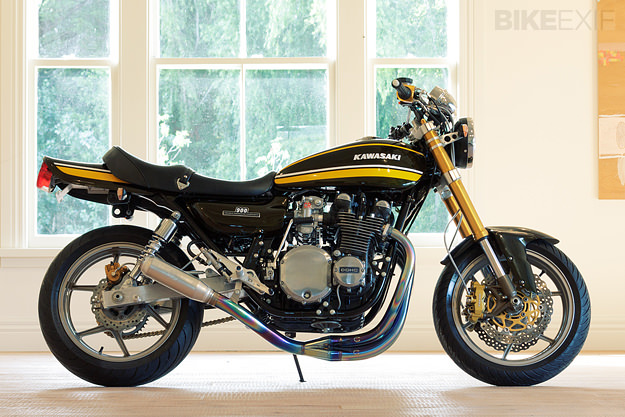
If you follow the race scene, you’ll probably know the name Graeme
Crosby. In the 1980s he won the Daytona 200, the Imola 200, the Suzuka 8
Hours, and the Isle of Man TT. And then promptly quit. He’s a national
icon in his home country of New Zealand, and there’s a steady stream of
visitors to his home and workshop in the rolling hills of Matakana, an
hour north of Auckland.
Crosby
might be retired but he’s as busy as ever, and age has not dulled his
energy. He’s set up a bike building operation called New Generation
Classics, and with the help of an ex-Britten mechanic, he’s turning out
some very interesting resto-mods—like this 1974 Kawasaki Z1A built for a
local enthusiast.
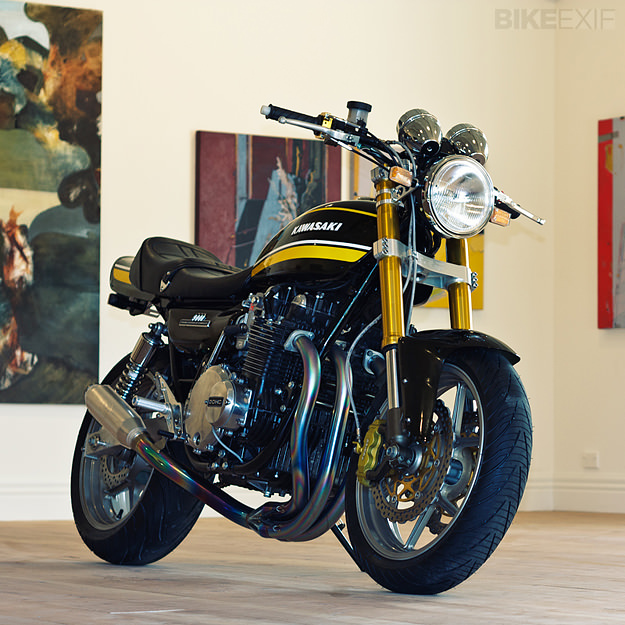
Given Croz’s connections to Suzuki and Yamaha, why Kawasaki? “Back in
the 70s the Z1 broke all the moulds,” he says. “It opened the floodgates
for many classic Japanese models. My plan was to marry new components
to the old classic, with a modern front end and high performance
brakes.”
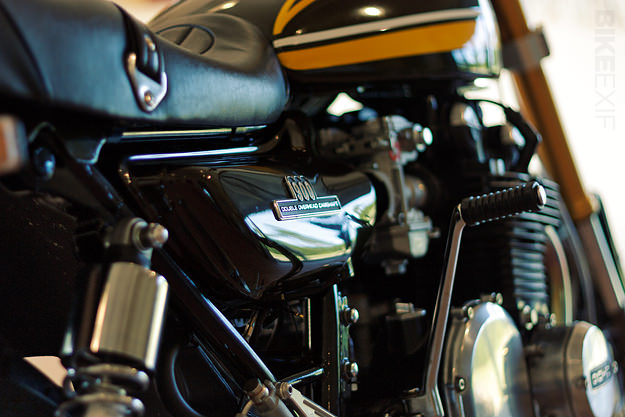
Having seen the bike in the metal, I can report that the plan has
worked. The classic lines appeal as strongly as ever—even that elongated
tail unit—but this machine has just the right mix of old and new.
The front end comes from a ZX10, lengthened 50mm to match the
original Z1 fork length and preserve the geometry. Crosby has designed
new top and bottom clamps to accommodate the upside down forks, moving
the tank back on the chassis a little. Streetfighter-style bars allow
maximum leverage for the rider.
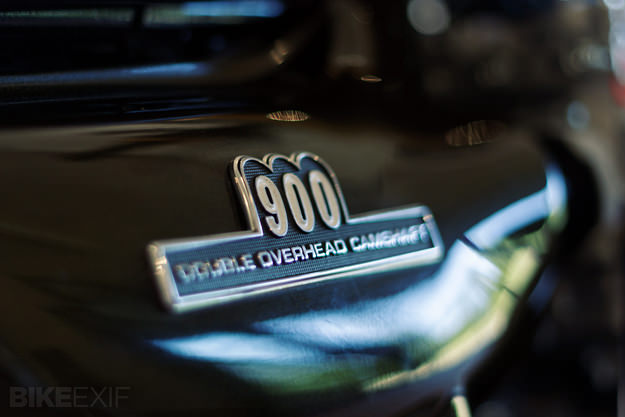
The swingarm is a classic Moriwaki alloy unit, designed to take a wide
ZX6 rear wheel. (It still meant offsetting the front sprocket to get the
chain alignment correct.) Moriwaki also supplied the titanium exhaust
system.
The engine has been beefed up with a Wiseco big bore kit, plus cams,
valves and springs from Yoshimura. Carburetion comes from a set of 33mm
smoothbore Keihins, with a Dyna ignition controlling the spark. With no
speedo drive to work with, Crosby has fitted an electronic speedo with a
shift sensor into the existing Z1 instrument bowls, with an electronic
tachometer to match.
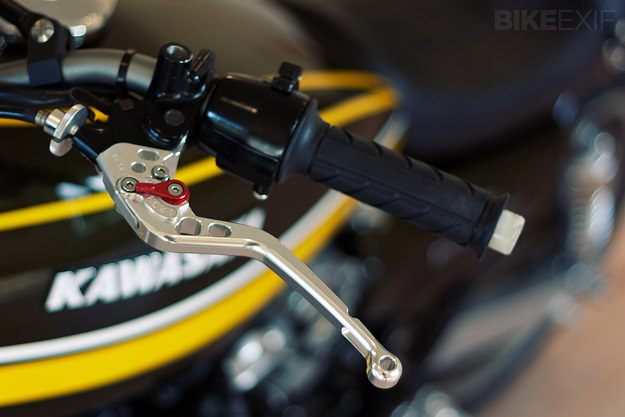
Some things just shouldn’t be changed, though, and in this case, that
means the color scheme. It’s the ultra-deep metallic green with yellow
stripes from Kawasaki’s 1974 range, but given extra depth with an
intriguing deep brown color shift that’s almost impossible to capture in
photographs.
Crosby obviously knows his stuff, and as word spreads about his New Generation Classics
operation, the commissions are rolling in. If you’re tempted by a piece
of history revamped by a racer who knows what works, drop Croz a line.
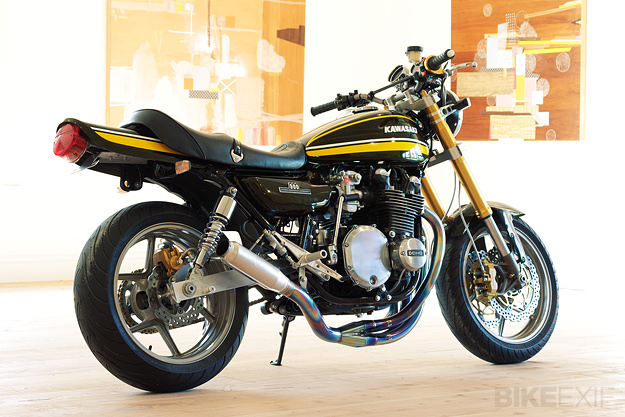 This Kawasaki is one of a dozen machines making an appearance at The Vivian gallery this weekend for the New Zealand launch of our book The Ride. If you’re in the Land of The Long White Cloud, we’d love to see you.
The article appeared first on www.bikeexif.com
This Kawasaki is one of a dozen machines making an appearance at The Vivian gallery this weekend for the New Zealand launch of our book The Ride. If you’re in the Land of The Long White Cloud, we’d love to see you.
The article appeared first on www.bikeexif.com
Last week, the Rides apart team had an awesome discussion
about the best performance motorcycle for the street. We heard a ton of
different opinions, but one major theme we noticed was people making
sacrifices in outright performance for a bike that could do a little
distance. Here are the bikes we’d choose to get you from a ride on the
highway to the canyons you need to carve.
What’s the difference between these bikes and the absolute best bikes
for street performance you ask? These bikes add a little power and a
little weight, making them geared better for sitting on the freeway and
they are also slightly more stable too. A KTM Duke 690 is one of the best thing’s I’ve ridden on a twisty road (though our reader Bammerburn’s 636
looks pretty awesome too) but the vibes of the KTM’s single cylinder,
or high pegs of the 636 make them uncomfortable for long stints on the
freeway or after sitting on them for a few hours. The bikes recommended
here split the difference. They offer more comfort for freeway rides,
but still carry the power to perform like you want them to on the
twisties.

2014 Kawasaki Ninja 1000 ABS – $11,999
Kawasaki’s 1000cc upright sport bike makes 140 horsepower, 82 pound-feet
of torque, and comes with ABS and traction control. It should stop
there, but if you need more convincing, it gets higher spec brakes than
Suzuki’s Hayabusa or GSX-R1000.
This bike is incredibly easy to ride around town, touring, or riding
fast on a fun road. RA readers Jeremyobryan and Bob both felt like it
did double-duty better than anything else, and we tend to agree with
them.

2013 Triumph Speed Triple R – $15,999
The Speed Triple (and Street Triple) R was the choice of many for best street performance bike. We went with other options as we’d rather be on something like the Ducati Hypermotard SP or KTM Duke
for pure twisty riding as long as it was close, but both those bikes
require aftermarket additions to make them capable of anything more than
brief stints on the freeway. The Speed Triple R, with its upgraded
brakes and suspension, and that incredible smooth and 133 hp and 82
lb.-ft. of torque makes sitting on the freeway a breeze and wringing it
out on tough roads incredibly rewarding.

2013 Ducati Multistrada 1200S Touring – $19,995
We’ve said it before and we’ll say it again, there really isn’t anything that is all-around as good as the Ducati Multistrada.
Semi-active suspension, multiple throttle configurations, ABS, and
traction control, paired with a 155 hp engine delivering 92 lbs.-ft. of
well spread out torque make this Multistrada very tailor-able to you
needs. It’s one of those bikes that out performs your expectations and
we have a hard time seeing a reason to take anything else. Watch Jamie
Robinson ride it around Spain here.

2013 KTM 990 SMT – $13,999
We’ve covered our love for supermoto’s time and time again, here at
RideApart, so a bike called a “Supermoto Touring,” or “Supermoto Travel”
depending on who you listen to, seems like it would fit the bill pretty
perfectly. If we’re being honest, we actually haven’t had a chance to
ride the 990 SMT yet, but it sits shoulder to shoulder on a very short
list of bikes we’d want to own personally. Reports put the gas mileage
in the low 30 mpg’s which, while we don’t love to see, is probably
something that we would put up with for that beautiful motor and KTM
quality component setup. Anyone want to bring their SMT by for a spin?

2014 Yamaha FZ-09 – $7,990
The FZ-09 is on the sportier side of our list, but we were impressed
with its ergonomics and great gas mileage and felt it deserved a spot on
the list. The 847 cc triple makes a modest 115 hp and 65 lbs.-ft. in
one of the flattest torque curves we’ve seen. Despite having such a fun
engine, the FZ-09 gets 40-45 mpg and, if that wasn’t enough of a
savings, the bike itself retails for only $7,990. The seating position
is upright to a degree that its comfortable, while just forward enough
that I wasn’t turned into a sail. I even found it to be the perfect
angle to use the wind to hold my 6-ft. frame up without much work. While
the engine of the Yamaha is beautiful, the fueling needs a re-map to
deal with being a tad jerky, and the suspension needs an upgrade if
you’re really going to put it through the paces. Still, if you’re
looking to ride a few hours to have fun on a nice road for cheap, this
is your jam.

2013 Honda CB1000R – $11,760
This de-tuned version of Honda’s CB1000RR makes for a brilliant
all-rounder, though is slightly less sophisticated compared to
Kawasaki’s Ninja 1000
and its fancy traction control. We spent some time on the CB1000R and
were impressed with both its comfort over long periods of time and how
much it made us want to misbehave. We’d be hard pressed to choose the
Honda over the Kawasaki in this category, but have no problems should
you choose to do so.

2013 Suzuki Hayabusa – $14,399
Yes, I’m aware the purpose of this list was to discuss things that were
fast and yet still comfortable, thus ruling out sport bikes. The thing
is, the Hayabua is actually really comfortable (and this is coming from a
guy who’s very rarely comfortable). We did a 190-mile loop for the
launch of the 2013 Suzuki Hayabusa, something that normally would have
me wincing with wrist, knee, and back pain but, after a full day of
riding, I was ready to go back out and do it again. Obviously, the Busa
is big as far as sport bikes go and, if you read my review,
you’ll see we also found the brakes to be a little too squishy; both
making the Hayabusa not as canyon capable as its 600 cc or 1000 cc
counterparts. Regardless, it’s still a whole lot faster and more fun to
ride on twisty roads than most bikes, while surprisingly capable on the
long haul.
First published in rideapart.com










































